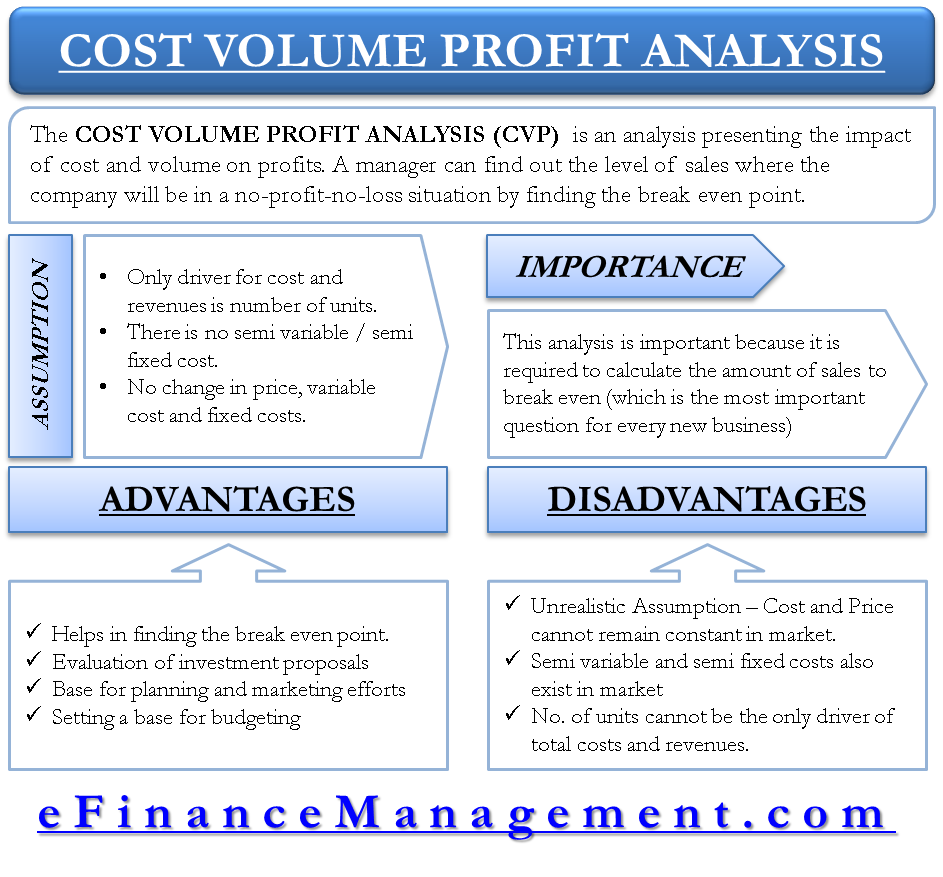Neither unit variable costs nor total fixed costs remain constant. B Fixed costs per unit stay the same within the relevant range c Costs are linear and can be accurately divided into.

Assumptions In Cvp Analysis Youtube
Total costs are directly proportional to volume over the relevant range.

. Cost-volume-profit analysis includes all of the following assumptions except the behavior of costs is curvilinear throughout the relevant range. All units produced are sold. Assumptions made in cost-volume-profit analysis.
Assumptions of cost-volume-profit analysis are useful only under certain conditions and only when certain hold true. Costs can be accurately separated into their variable and fixed components. The technique of cost-volume-profit analysis rests on a set of assumptions.
More Assumptions of CVP Analysis. The behavior of costs is curvilinear throughout the relevant range. Selling prices are to be unchanged.
Costs are linear and are designated either variable or fixed. Total variable costs are directly proportional to volume over the relevant range. Cost-volume-profit analysis includes all of the following assumptions except a.
The assumptions of the CVP are. Costs can be classified into variable and fixed components. The behavior of costs is curvilinear throughout the relevant range.
Cost-volume-profit analysis includes all of the following assumptions except. 58 Cost-Volume-Profit Analysis Summary. Any analysis whether graphical or algebraic makes certain assumptions about the behaviour of costs and revenue.
3Changes in inactivity are the only factors that affect costs. These assumptions and conditions are as follows 1Costs can be classified accurately as either variable or fixed. Cost- volume-profit Analysis assumptions include which of the followingA.
Question 11TCO 4 Assumptions underlying cost-volume-profit analysis include all of the following except. B both unit variable costs and total fixed costs remain constant c Neither unit variable costs nor total fixed costs remain constant d A and B are correct e A and C are correct. Selling prices are to be unchanged.
The price of a product or service will not change as volume changes. Costs can be classified accurately as either variable or fixed. Changes in activity are the only factors that affect costs.
Costs can be classified accurately as either variable or fixed. The behavior of revenues and expenses is accurately portrayed as linear over the relevant range. The behavior of costs is curvilinear throughout the relevant range.
In the case of the firm or business which sells the multiple products the sales mix will be constant. Selling price is constant. 1 out of 1 points Cost-volume-profit analysis includes all of the following assumptions except Selected Answer.
These assumptions may be identified as the fundamental base of such analysis. Which of the following are assumptions of cost-volume-profit analysis. What Assumptions Does Cost-Volume-Profit CVP Analysis Make.
Revenue per unit of output is constant. Costs can be accurately separated into their variable and fixed components. This means that a company can sell more or fewer units at the same price.
The variable element is constant per. The behavior of costs is curvilinear throughout the relevant range. Cost-volume-profit analysis includes all of the following assumptions except a.
To summarize the most important assumptions underlying CVP analysis are. 2All units produced are sold. Cost-volume-profit analysis includes all of the following assumptions except.
The reliability of CVP lies in the assumptions it makes including that the sales price and the fixed and variable cost per unit are. In its simplest form cost-volume-profit analysis makes the following assumptions. Cost-volume-profit Analysis assumptions include which of the following.
All units produced are sold. Costs can be classified accurately as either variable or fixed. Changes in activity are the only factors.
These cost volume profit analysis assumptions are as follows. Volume is the only relevant factor affecting cost. Changes in activity are the only factors.
Thus total revenue varies directly with volume TR PQ Total Revenue is Price of each unit the unit Q. Costs can be classified accurately as either variable or fixed. Costs can be classified accurately as either variable or fixed.
Selling price variable cost per unit and total fixed costs remain constant through the relevant range. Costs are linear and can be accurately divided into variable and fixed elements. 5 all costs can be divided into fixed and variable elements.
Which of the following is not an assumption of cost-volume-profit analysis. Changes in activity are the only factors that affect costs. Sales price is the only relevant factor affecting costQuestion 22TCO 6 A basic.
All costs can be divided into fixed and variable elements. A Costs can be accurately seperates into their variale and fixed components. The behavior of costs is curvilinear throughout the relevant range.
Cost Volume Profit Analysis assumptions include which of the following. Changes in activity are the only factors that. The time value of money is incorporated in the analysis.
A number of assumptions underlie cost-volume-profit CVP analysis. Question 2 1 out of 1 points Chung. The assumptions underlying the cost-volume-profit analysis are discussed below.
Both unit variable costs and total fixed costs remains constant. A and C are correct. The number of output units is the only driver.
A an B are correctE. Check all that apply a In multi product companies the sales mix is constant. All costs can be divided into fixed and variable elements.
The selling price per unit will be constant and will not decrease increase grounded on volume.

Cost Volume Profit Analysis Definition Objectives Assumptions Limitations

Chapter 4 Marginal Costing And Costvolumeprofit Analysis Cost

Cost Volume Profit Analysis Define Assumption Pros Cons Importance
0 Comments